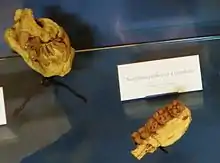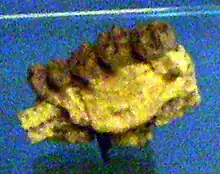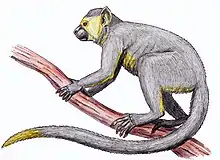Samburupithecus
Samburupithecus is an extinct primate that lived in Kenya during the middle to late Miocene. The one species in this genus, Samburupithecus kiptalami, is known only from a maxilla fragment dated to 9.5 million years ago discovered in 1982[1] and formally described by Ishida & Pickford 1997.[2] The type specimen KNM-SH 8531 was discovered by the Joint Japan-Kenya Expedition at the SH22 fossil site in the Samburu District,[1] a locality where several other researchers found no ape fossils.[3]
| Samburupithecus Temporal range: | |
|---|---|
 | |
| Samburupithecus kiptalami fossils, Muséum national d'histoire naturelle, Paris | |
| Scientific classification | |
| Domain: | Eukaryota |
| Kingdom: | Animalia |
| Phylum: | Chordata |
| Class: | Mammalia |
| Order: | Primates |
| Suborder: | Haplorhini |
| Infraorder: | Simiiformes |
| Superfamily: | Hominoidea |
| Family: | incertae sedis |
| Genus: | †Samburupithecus Ishida & Pickford 1997 |
| Species: | †S. kiptalami |
| Binomial name | |
| †Samburupithecus kiptalami | |
Samburupithecus lived during the so-called "African ape gap" 14 to 7 Ma, a period from which very few hominoid fossils have been found in Africa until relatively recently.[3] This apparent gap, however, is now populated by a diversity of apes such as Nakalipithecus, Chororapithecus abyssinicus,[3] Otavipithecus,[4] and Nacholapithecus.[5]
Characteristics

Samburupithecus was approximately 60 kilograms (130 lb)[6] and was most likely a frugivorous terrestrial quadruped. Paleoenvironmental reconstructions indicate that Samburupithecus most likely lived in a wooded habitat surrounded by savannah.[7]
Defining cranial traits of this genus include low, broad zygomatics, straight alveolar process and large maxillary sinus. Defining dental traits include three-rooted premolars, thick enamel and bunodont cusps.[8]
The teeth in the Samburupithecus type maxilla are comparable in size to those of the type mandible of Nakalipithecus, roughly the size of a modern female gorilla. The upper premolars of both are elongated mesiodistally (along the row of teeth), but those of Samburupithecus have more inflated cusps that are positioned more centrally, so that occlusal foveae and basins (depressions at top of teeth) are very restricted. This suggests that Samburupithecus was strongly specialized compared to other Miocene and extant apes. Another distinguishing feature between the two is the higher relief of the dentine/enamel junction in Samburupithecus.[9]
These elongated teeth are unlike many other Miocene hominoids, linking Samburupithecus the taxon to gorillas, chimpanzees and hominins, but its relationships within this clade is at present unclear.[10] Because of this mixture of primitive and derived traits in the KNM-SH 8531 specimen, it has been proposed that Samburupithecus lived before the gorilla-chimpanzee-hominin split and, therefore, that it is a common ancestor to these primates alongside Ouranopithecus.[11]
See also
- List of fossil sites (with link directory)
- List of human evolution fossils (with images)
Notes
- Yasui, Nakano & Ishida 1987
- Ward & Duren 2002, p. 395
- Bernor 2007
- Ward & Duren 2002, p. 386
- Sawada, Y.; Saneyoshi, M.; Nakayama, K.; Sakai, T.; Itaya, T.; Hyodo, M.; Mukokya, Y.; Pickford, M.; Senut, B.; Tanaka, S. (2006). "The Ages and Geological Backgrounds of Miocene Hominoids Nacholapithecus, Samburupithecus, and Orrorin from Kenya". Human Origins and Environmental Backgrounds. Developments in Primatology: Progress and Prospects. Springer. pp. 71–96. doi:10.1007/0-387-29798-7_6. ISBN 978-0-387-29638-8.
- Fleagle 1999, p. 456
- Tsujikawa 2005, Abstract
- Ward & Duren 2002, p. 393
- Kunimatsu et al. 2007, Comparisons with Other Hominoids
- Fleagle 1999, p. 464
- Cela-Conde & Ayala 2007, p. 108
References
- Bernor, Raymond L. (December 2007). "New apes fill the gap". PNAS. 104 (50): 19661–2. Bibcode:2007PNAS..10419661B. doi:10.1073/pnas.0710109105. PMC 2148351. PMID 18077396.
- Cela-Conde, Camilo J.; Ayala, Francisco J. (2007). Human Evolution — Trails from the Past. Oxford University Press. ISBN 9780198567806.
- Fleagle, J.F. (1999). Primate Adaptation and Evolution. Elsevier Academic Press. ISBN 978-0-12-260341-9.
- Ishida, Hidemi; Pickford, Martin (1997). "A new Late Miocene hominoid from Kenya: Samburupithecus kiptalami gen. et sp. nov". Comptes Rendus de l'Académie des Sciences, Série IIA. 325 (10): 823–29. Bibcode:1997CRASE.325..823I. doi:10.1016/S1251-8050(97)82762-0.
- Kunimatsu, Yutaka; Nakatsukasa, Masato; Sawada, Yoshihiro; Sakai, Tetsuya; Hyodo, Masayuki; Hyodo, Hironobu; Itaya, Tetsumaru; Nakaya, Hideo; Saegusa, Haruo; Mazurier, Arnaud; Saneyoshi, Mototaka; Tsujikawa, Hiroshi; Yamamoto, Ayumi; Mbual, Emma (December 2007). "A new Late Miocene great ape from Kenya and its implications for the origins of African great apes and humans". PNAS. 104 (49): 19220–5. Bibcode:2007PNAS..10419220K. doi:10.1073/pnas.0706190104. PMC 2148271. PMID 18024593.
- Tsujikawa, Hiroshi (2005). "Palaeoenvironment of Samburupithecus Based on its Associated Fauna" (PDF). African Study Monographs. Suppl. (32): 51–62.
- Ward, Steven C.; Duren, Dana L. (2002). "Middle and late Miocene African hominoids". In Hartwig, Walter Carl (ed.). The Primate Fossil Record. Cambridge University Press. Bibcode:2002prfr.book.....H. ISBN 978-0-521-66315-1.
- Yasui, Kinya; Nakano, Yoshihiko; Ishida, Hidemi (March 1987). "Excavation at the Fossil-Hominoid-Bearing Locality, Site-SH22 in the Samburu Hills, Northern Kenya". African Study Monographs. Suppl. 5: 169–74. hdl:2433/68329.



